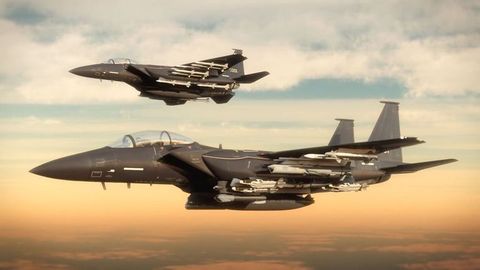USAF's Next Budget Request Will Include New F-15X Advanced Eagle Fighter Jets: Report
We revealed the existence of the F-15X concept last July and now it seems like it may become a line-item in the upcoming 2020 defense budget.
ast July, I broke a story about the existence of Boeing's F-15X Advanced Eagle concept, one that the plane-maker had been in discussions with the USAF about for many months. That aircraft would be procured to replace America's existing F-15C/D aircraft, the vast majority of which are operated by the Air National Guard. Since my expose, the USAF has officially remained somewhat flippant about the F-15X and its talks with Boeing, which isn't surprising, but according to a Bloomberg report, that is about to change dramatically very soon.
The F-15X airframe would be single seat, but it would incorporate decades of innovations that are being applied currently in the latest F-15 Strike Eagle derivatives being purchased by Saudi Arabia (F-15SA) and Qatar (F-15QA). With an
airframe life of a whopping 20,000 hours [emphasis added, would sure suit RCAF), and the latest sensors, flight control systems, and avionics, the F-15X would serve for many decades at an operating cost that Boeing claims will trounce that of the existing F-15C/D fleet—the youngest of which is now 32 years old—basically paying for the airframes with savings within about a decade.
Roxana Tiron of Bloomberg Government writes that the USAF will include "$1.2 billion for 12 Boeing F-15 X fighter aircraft" in its 2020 budget request that is due to be published in February. The story also notes that pressure to buy the F-15X is coming from the powers that be inside the Pentagon that are external to the USAF itself, which would explain the disconnect over potential procurement program with the service's top leadership:
"The decision to buy the newest kind of F-15 aircraft, so far only sold to U.S. allies, comes from the Pentagon’s top leadership, including with some prodding from Deputy Secretary of Defense Pat Shanahan, and not the Air Force, which would be flying the planes, the two people said. Shanahan, a former Boeing Co. executive, recused himself from any decisions related to Boeing when he was confirmed by the Senate."
You can read Tiron's report in its entirety here [ https://about.bgov.com/blog/pentagon-billion-new-boeing-fighters/ ].
Until the budget request is released, these things can always change. But this report would line up with what I have heard about the concept and how it has support from top officials at the Pentagon. We also don't know what the structure of the deal would look like, if it is just for a dozen F-15s or if it also includes additional items and services.
Our sources say that Boeing has been eager to package the F-15X with aggressive business terms in order to make the USAF an Eagle customer once again. This could include a low or even zero cost development of the new subtype, as well as guarantees on unit cost and even the price of elements of the aircraft's sustainment over time. Boeing has been ultra-aggressive with their aircraft bids as of late—a strategy that helped win them the UH-1 replacement tender, the Navy's MQ-25 Stingray tanker competition, and the prized T-X next generation Air Force jet trainer contract.
The idea behind the whole F-15X initiative is not to compete directly with the F-35, but to provide the USAF with a fiscally and operationally attractive "plug and play"
option for replacing the rapidly aging F-15C/D fleet comprised of roughly 235 aircraft [emphasis added]. These jets will need invasive and costly upgrades in the coming years in order to remain airworthy and relevant for front-line operations...
The reality is that for many tasks, including the homeland air sovereignty operations, the low-observable features of an F-35 are useless. There are many combat missions that actually benefit from a heavy fighter that can carry large stores over long ranges, as opposed to a stealth fighter with more limited payload and range capabilities. Israel seems to have come to this conclusion as well, incidentally. This is where the F-15X also comes into play for the USAF. Once again, read all about this aircraft and how it fits into the USAF's force structure in my past feature that unveiled it [ http://www.thedrive.com/the-war-zone/22372/exclusive-unmasking-the-f-15x-boeings-f-15c-d-eagle-replacement-fighter ]...
http://www.thedrive.com/the-war-zone/25636/usafs-next-budget-request-will-include-new-f-15x-advanced-eagle-fighter-jets-report




